Cincinnati is working on a new power aggregation deal right now that could lead to the entire city being powered from 100 percent renewable energy sources. The deal, city officials say, could be finalized within the coming months and be in place for consumers by summer 2012.
Such a move would make Cincinnati the largest city in the United States to have its energy supply come from 100 percent renewable sources, and it might be accomplished without any significant cost difference for ratepayers.
The way it would work, city officials tell UrbanCincy, is by requiring power providers to include quotes for both the cheapest electricity available and 100 percent renewable electricity. In Oak Park, IL, for example, the bids came back so competitive that city officials decided to go with the 100 percent renewable solution.

Cincinnati businesses and homeowners may be supplied by 100% renewable energy as soon as this summer.
“There is no guarantee that our bids will come in the same as Oak Park’s, but the question may be whether we are willing to pay an additional one percent to pay for renewable energy,” explained Office of Environment Quality (OEQ) director Larry Falkin.
The movement towards sustainability has evidently picked up steam in Cincinnati as of late. At the first of two required public hearings, approximately 70 people came out to speak in favor of using completely renewable energy sources, and the environmental advocacy group Greenpeace flew a hot air ship over Cincinnati last week advocating for such change.
“The biggest thing impacting our carbon footprint is how we get our electricity,” said Falkin who explained that Cincinnati currently gets approximately 85 percent of its energy from coal. “This is probably the biggest opportunity we’ll have over the next several years to dramatically reduce Cincinnati’s carbon footprint.”
After a positive first hearing at City Council’s Budget & Finance Committee, officials expect that the effort will move forward and receive approval from the full council on Wednesday. Should that take place, the request for proposals (RFP) would then go out within the next two to three weeks.
Even if the response to the city’s RFP does not come back as favorable as Oak Park’s, city officials may be able to structure the deal to offer consumers a choice between the cheapest electricity option and a 100 percent renewable electricity option.
“There are a lot of things Cincinnati is doing to position itself as a leader in sustainability and going green – both in the public and private sectors,” Falkin concluded. “This is a significant part of that total package in terms of branding Cincinnati as a progressive city, and cities across the country may start to look to adopt the Cincinnati solution for energy.”
The final Budget & Finance Committee meeting scheduled to discuss power aggregation will take place today at 1pm at City Hall (map).






